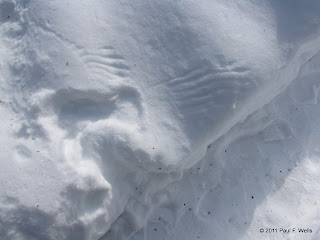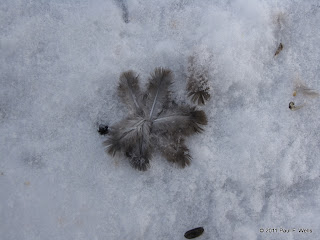A couple of weeks ago I wrote about finding evidence of a large bird having landed near some of our feeders and wondered if a hawk was haunting the area. These suspicious were confirmed last weekend.
Around noon on Sunday, January 23, I looked out a second-floor window onto the feeding area and saw more marks made by large wing feathers in the snowbank; they're barely discernible in lower center right of this shot [click on it to bring up a larger copy of the image]:
Here's a close-up shot, taken from ground level:
Once I got a good look at the wing marks I began searching for further evidence. There was nothing right there under this feeder, but back up on the path in front of the house there was plenty of it--lots of feathers in the path and in the snow banks:
There was one largish feather sticking out of the snow in a bank near the house:
I dug around it a bit and quickly uncovered a small trove of others:
Judging from the color, and the spots on some of them, I think the victim was most likely a Mourning Dove. Of which there are plenty around here. The photo on the Cornell site shows feather spots like quite clearly.
I kept looking around for more evidence and noted an odd depression in the snow on the opposite side of the path, on the lawn. I trudged through the knee-deep snow to get a better look and was rewarded by finding a very clear imprint of a large bird:
He or she came down facing the house, and had probably approached from one of the trees in the middle of the front lawn. I didn't think to measure the print but the most likely culprit was a Cooper's Hawk. It was definitely much larger bird than a Sharp-shinned Hawk like the one that crashed into the house in late December.
After gathering what evidence I could I made mental plans to do a blog post about what I'd found, but before I had the chance to do so the hawk struck again! On Wednesday afternoon, about 3:15, I again looked out at the feeder area from the upstairs window--I check the area frequently to see what visitors we're hosting--and saw what looked like a couple of feathers underneath the large bottle feeder. I went out to investigate, and, sure enough, it was a small tuft of feathers, this time with a bit of bloody flesh attached. These had a reddish tinge to them, so I suspect that a female Northern Cardinal was the victim this time.
I again walked back towards the front of the house and again found the marks of large wings in the snowbank. [NOTE: The late-afternoon light was very poor for taking pictures so I've cranked up the contrast in this and the following shots to exaggerated, grossly unnatural levels in order to bring out the detail.]:
I went back in the house, thinking that I'd seen all that was to be seen, but when I looked out a second-story window at the front of the house I was surprised to again see a strange imprint in the snow. I went back out, camera in hand, and again trudged through the deep snow to get a better look. There, not ten feet from where the earlier imprint had been, and in much the same orientation, was clear evidence of another crash-landing by a large bird:
I don't quite know how to interpret the marks up near where the head was; it almost looks as though a Pterodactyl was here! The bird must have been thrashing around and those marks are tracks left by its beak.
This time I had the presence of mind to bring out a tape measure in order to give some sense of scale:
Again, click on the images to bring up a larger copies and to make the numbers on the tape readable. The spot where I placed the end of the tape was probably not where the top of the bird's head actually was, so the reading of 24" is probably too long. The Sibley guide gives 16.5" as the average length of a Cooper's Hawk; the Cornell site gives 14.6-15.4" as the average length for a male and 16.5-17.7" for a female -- females of most raptor species are generally larger than the males. If my bird really was nearly 2' long from stem to stern, that would suggest a Northern Goshawk. Not impossible, but Goshawks are birds of the deep woods. Unless and until I actually get a good look at our local predator, I'm going to assume that it's most likely a female Cooper's Hawk.
Since finding the second set of evidence I've been more vigilant about monitoring activity outside the house. So far there's been no further sign of the hawk. Thinking back, however, I recall that on the day before the second kill I'd noted some odd behavior from a male Hairy Woodpecker. Hairys are a nearly-constant presence at our suet, so it was not at all surprising to see one clinging to the tree just under one of the suet feeders. What was surprising was that when I checked again, several minutes later, he was still there, in nearly the same spot. I made subsequent checks over the course of several minutes, and though he moved a bit, he never got far from the position in which I first saw him. It was almost as if he was frozen to the tree. I finally went out to check on him, thinking there might be something wrong with him, but upon my approach he flew away very quickly. I wonder now if the "frozen" bird was adopting that posture to avoid being spotted by a hawk?













There's always the possibility that the culprit was a lobster. Take another look at that snow imprint! An arthropod for sure!! And it's Maine!
ReplyDeleteTrue enough! But would a lobster eat enough to take two birds within a period of four days?
ReplyDelete